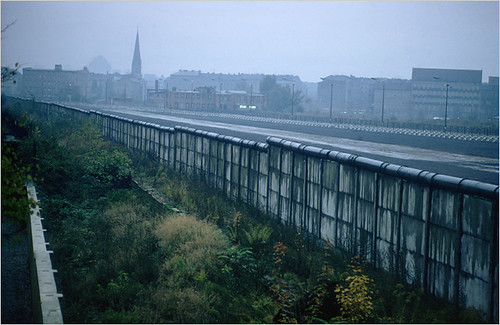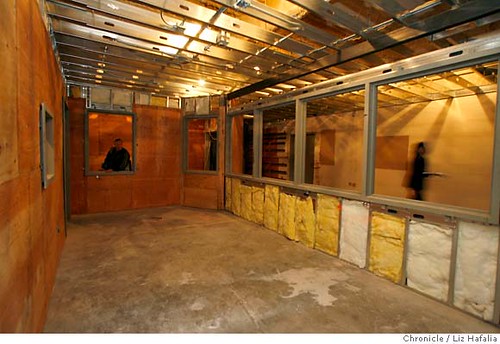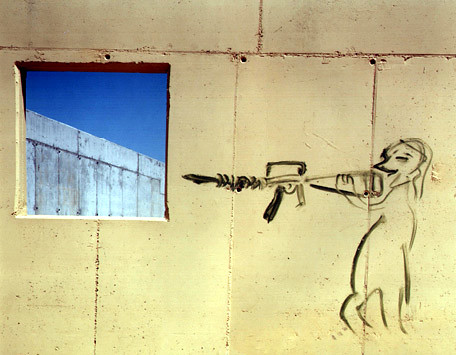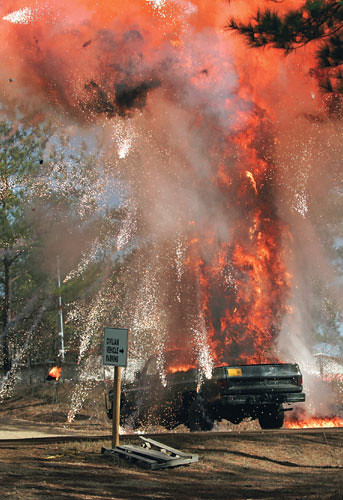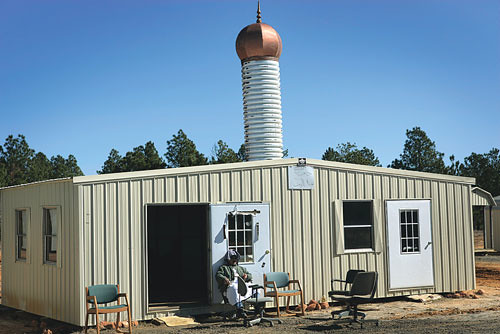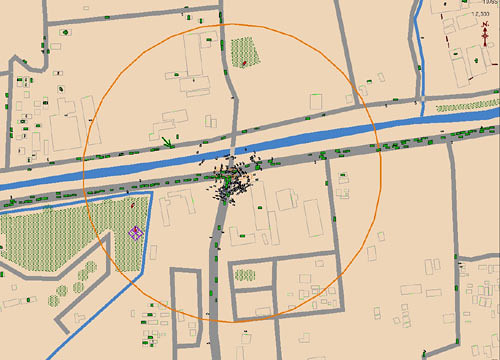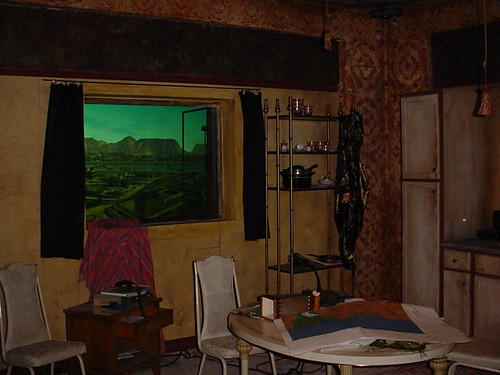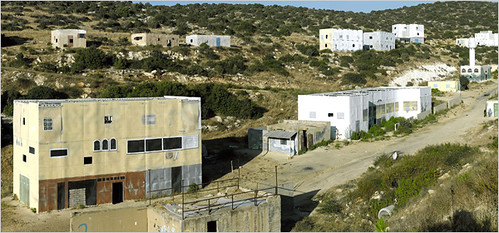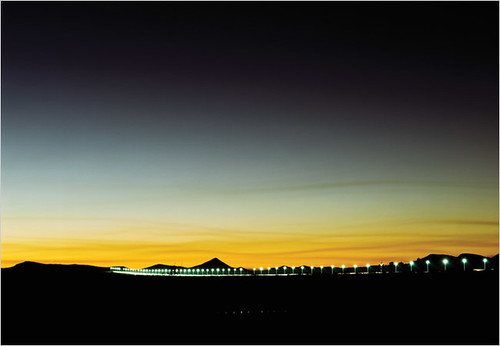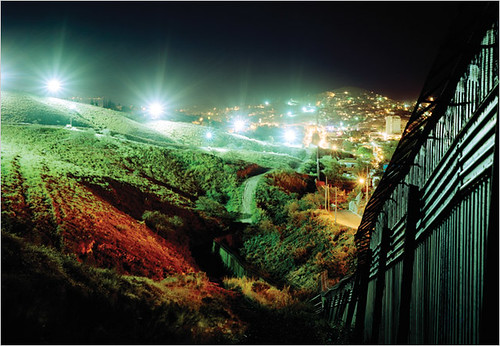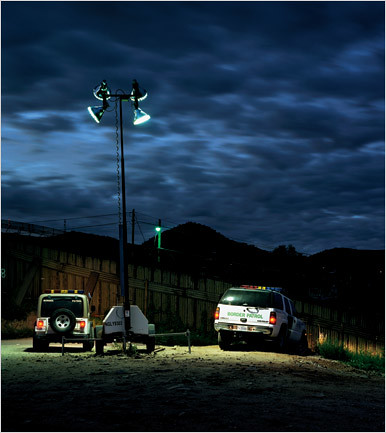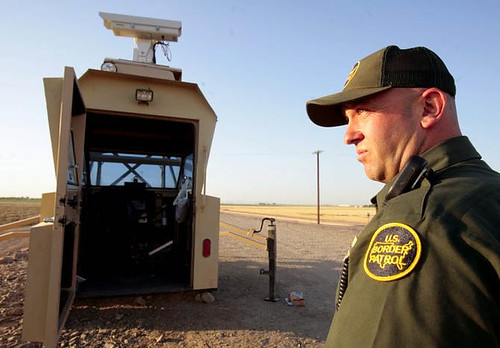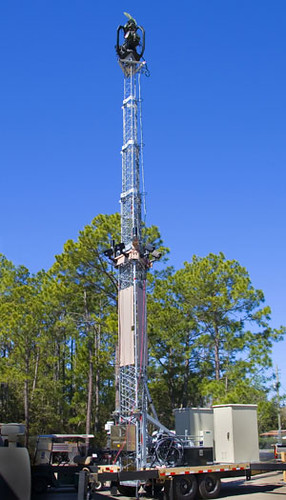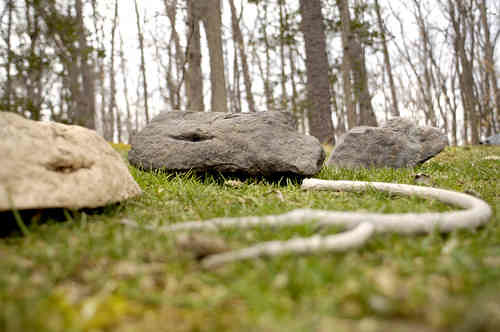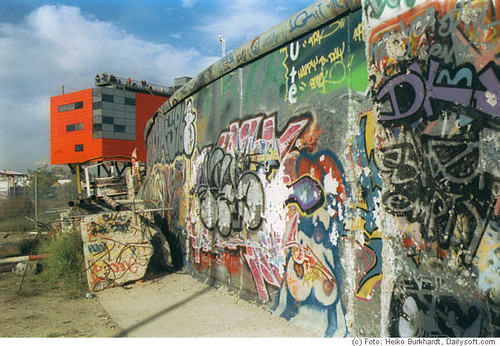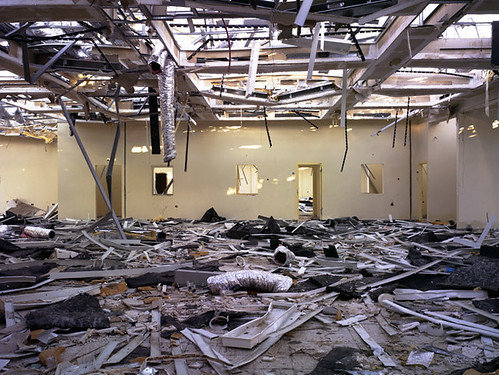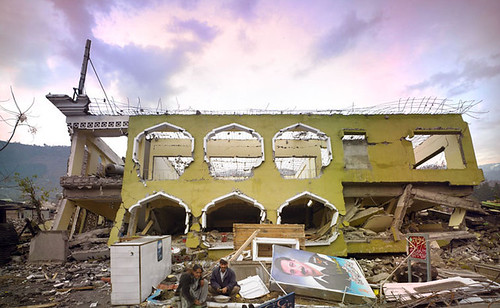It’s been a while since I updated you all on the development of recent
global border fence infill – if I may call it that – which has cropped up in the past few months and with no signs of slowing down since my last post on this topic in January. In fact, you might say the opposite is true.
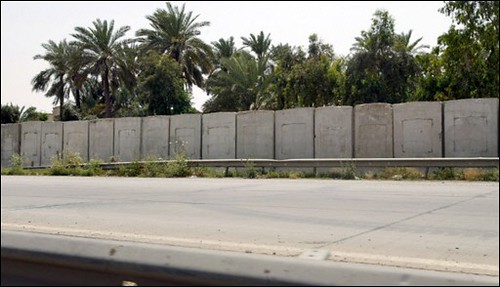 [Image: A picture of the wall being built around the Sunni neighborhood of Adhamiyah in Baghdad. Photo via France 24.]
[Image: A picture of the wall being built around the Sunni neighborhood of Adhamiyah in Baghdad. Photo via France 24.]The self-referential nature of this border fence spawn all around the world is so intriguing in part because of the rapidity at which they are being proposed, built and contested. This hyper-construction also seems to mimic the rate at which more central stages of geopolitical division are continuing to descend into deeper political chaos. How can we not see all of these security barriers amounting to a much greater architectural system of exclusionary spatial practice, emanating from severe fractures and tensions in the tectonic integrity of neoliberalist expansion?
 [Image: An Iraqi boy squeezes through a gap in a stretch of security barrier erected in Baghdad's Azamiyah neighborhood. Photo via SFGate.]
[Image: An Iraqi boy squeezes through a gap in a stretch of security barrier erected in Baghdad's Azamiyah neighborhood. Photo via SFGate.]These borders are produced by both global and local economic pressures, and selectively admit and deny the passage of people on various levels of identification and entry, through formal welcoming gates as well as more clandestinized spaces of violence. While some pass daily in seas of commuter traffic, others are forced to tunnel along
underground superhighways where death is already prefigured into the massive concrete sewer corridors which have acted as mass graves for imperiled migrants now for years. While some are biometrically scanned and bureaucratically approved, others forfeit their identities and their limbs while clinging to the sides of trains roaring towards the northern Gringo Land long past midnight. Some are given long term visas while others merely a day pass. There are those who are forced across in shackles or blindfolds while others
hide in the chairs or dashboards of smuggler vehicles, passing small hordes going the reverse direction gleefully driving their RV’s across the border with their dogs and families. There are sub-compartmentalized dimensions of secret clearances and private institutional permission, and other covert crossings contrasted by a much more spectacular fringe of constant cross-border activity – while most of the divided territories are masked in the expanse of a natural landscape making the nations all the more impossible to distinguish. And while the birds and the bees travel back and forth as easily as the wind, other multidirectional flows of traffic are directed by a matrix of military surveillance grids and counter cartographies of guerilla subversion.
Today’s border evolution, with entire Fence Laboratories devoted to its securitzed sophistication, frighteningly strives towards a perfect technomilitaristic artifice of perhaps (dare I even say)
an apartheid sublime; or, a kind of hyper-wall that can filter – in some automated caste system-like surveillance regime – the socio-economic and racial identification of any person who seeks to pass. It becomes a membrane through which various advents of space and biopolitical hierarchy open up – it’s the kind of wall you might expect one day in the grimmest of futures to surveillance the world all on its own. But, I digress and get carried away, however, so…forgive me.
When I think about places like Iraq or the West Bank, or parts around India and
La Linea that’s being accentuated by a series of individual smaller fences along side Mexico, the overall effect looms over these continents as if governed by a grand tyranny of border fencing, like these barriers were the physical manifestations of an entire political system that only existed in built form, in architectural divisions – an institution of intelligent border fences; or, rather as a pervasive urban consequence to a much larger and more abstract bureaucratic phenomenon. All of these fences some how simplify the cruel complexity of today’s global politics and pervert the final frontier of human rights that is the freedom of movement.
Obvious frontiers like Jerusalem and Baghdad seem like the heads of this massive snake; the critical geopolitical pressure cookers from where the rest of the political climates across the globe are regulated and controlled. With recent stories focusing on Baghdad and the American military’s rogue plan to build a massive three-mile long wall around the Sunni enclave of Adhamiyah, this is as good a time as any to relay some other stories I’ve come across with regards to the seemingly endless construction of a global border. Though, you’ll have to forgive some of the larger at length quoting and excerpting from some of these articles while I try to sum up the consistency of this divisive proliferation.
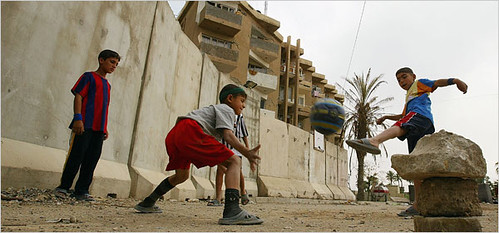 [Image: From 'Gated Communities' For the War-Ravaged' in the Washington Post. Photo by Wathiq Khuzaie (Getty Images).]
[Image: From 'Gated Communities' For the War-Ravaged' in the Washington Post. Photo by Wathiq Khuzaie (Getty Images).]So, you’ve no doubt heard by now about the controversial plan American military strategists hatched to build a massive concrete wall around the neighborhood of Adhamiyah in Baghdad. This, the Americans said, was part of a larger effort to secure the area and prevent terrorist movements within the neighborhood. It was of course billed as a protective measure for the Sunnis, even referring to it as a “center piece” for a larger objective of turning different neighborhoods through out Baghdad into
“gated communities” that would by some stroke of miracle stem the uncontrollable sectarian violence.
Only thing is: neither the local Sunnis or Shiites are down with it. Even less surprising, the American government didn’t really consult with anyone prior, not even the Iraqi PM who announced his own total disapproval of the wall and
ordered its construction to be halted. Did the American government really think that anyone in the Arab community would embrace the idea of extending a wall through out their ancient city – I mean, given the tantamount associations most Arabs have with the Israeli wall that has literally carved the Palestinian people out of Jerusalem and into peri-urban prison-like reservations?
Needless to say, Jerusalem and Baghdad are looking more and more similar despite these massive 12 foot high concrete walls segregating the different religious sects. So far,
3,000 separate slabs of concrete blast wall have been placed around the Sunni city since the plan was put into action 2 months ago, each weighing roughly 14,000 pounds. “These barriers included both Jersey barriers — short concrete dividers commonly seen on roadways in the United States — and larger 20-foot blast walls that commonly surround bases and living areas.”
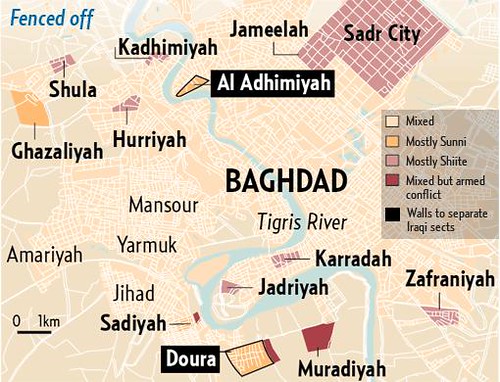 [Image: Entrances to and exits from Al Adhamiyah will be manned by Iraqi soldiers. The wall will be five kilometres long and include sections as tall as 3.5 metres. Map via Gulf News.]
[Image: Entrances to and exits from Al Adhamiyah will be manned by Iraqi soldiers. The wall will be five kilometres long and include sections as tall as 3.5 metres. Map via Gulf News.]According to
this article, “Besides Adhamiyah, barriers are going up in Ghaziliyah, Khadra and Ameriyah in western Baghdad - all Sunni areas - and three are being built in the southern Rashid district in locations that officials didn't specify.”
However, this
latest dispatch from the
Washington Post, says the U.S. is defending its plan to construct the wall and is proceeding with sealing at least 10 neighborhoods despite opposition from Iraqi leaders. In addition, U.S. forces are also planning to use biometric technology to track residents in Baghdad, while troops are also actively compiling neighborhood census data by recording the fingerprints and eye patterns of locals.
Of course, the greatest “gated community” in Iraq is the Green Zone, but even that compound was recently attacked by someone who’d managed to circumnavigate security and get within reach of the Parliament building. Bottom line is, and Anthony Cordesman, a Middle East expert at the Center for Strategic and International Studies in Washington, D.C confirms as much (in the same article), the walls – while creating a certain degree of protection – only further adds to the sectarian violence. At best, it is a dismal short term solution with much more severe long term repercussions. A recent piece by Alissa Rubin in the
New York Times does a good job of articulating how
demeaning the gesture of the wall is – as if that were the only solution the Americans could come up with after what they have let become of Iraq post-Saddam. Actions like these make it more and more apparent to me how the military is capable of engineering spaces of conflict; their walls and checkpoints not only produce conflict zones, but exacerbate them once they already exist. The Americans looks so ignorant of their own failure that they must stoop to these types of last ditch efforts and “banal militarism.” Though, Rubin’s piece points out an interesting irony, that the wall has actually united the Sunnis and Shiites. Perhaps an inadvertent consequence of the American’s poor idea? At least there is some positive side effect.
It’s absurd, but what if the American military went on a lonely wall-erecting spree with the intention of pissing off the entire Arab community so badly that the sectarian violence came together in a massive re-solidarity of their nation-states to oppose the wall, or this network of American walls? Yes, it’s insidious and I would not promote such a tactic, but if the ignorance of the wall could some how be compensated by the good fortune of actual unity, and not increased sectarian violence as these walls conjure. Everyone knows that these walls only ratchet up to boiling points the political violence so that these “gated communities” in the end function more like strategic pressure cookers where violence can froth over in designated frontiers within the city instead of less predictable spaces. This become a way of forcing the warfare into controlled areas, but at the cost of increasing the tensions.
But, that’s only a snippet of the border-plagued urbanism that haunts the internal spaces of the nation’s capital, the external boundary of Iraq itself is also seeing tremendous rapid transformation. The
CBS News reported back in January that “More than 40 Iraqi military installations now dot Iraq's border with Iran,” and the coalition just finished establishing another 200 along Iraq’s other borders. The Zurbathia port of entry is one of the closest to the Iraqi capital, and apparently considered the "center of gravity where many security problems exist. The piece talks about
the practical issues of training more border agents, lacking the means to properly house them along the border (as most already live in decrepit modular housing units), and some of the less formidable checkpoints between Iran and Iraq that signify the flexing political clout and military build up that is being exhibited by Iran.

That’s not the only border Iran is worried about, though. They’ve
recently begun construction of “a 700 km-long concrete wall along its border with Pakistan.” Just west of Quetta,
the wall is being built from the nearby border town of Taftan. And, typical with most border fencing, it isn’t stopping for anything in its path either. From this article, “Residents of the Sorap locality in the Mand area of western Mekran region in Balochistan province told a group of journalists visiting the area that they did not know why the Iranian border forces were asking them to leave their homes.” Without much more warning than that, the Iranian government gave this Pakistani border town just 10 days to abandon their lives there.
But before we make our jaunt over to Pakistan, let me quickly finish this mini-tour of the Middle East’s barricade frenzy.
Apparently, “a prominent sheik of the Wayilah tribe” living along the border between Yemen and Saudi Arabia,
threatened to fight the Saudi Arabian government for building “a security fence 4 to 7 km beyond the neutral zone inside Yemen, stretching from Jabal Hobash to Jabal Al Fara.” With some extra nudging from Egypt and the U.S., the Saudi government “did accept to remove the separation fence along its border with Yemen.”

Of course, no mention of the Middle East in terms of borders could be complete without some dispatch of the latest developments along Israel’s borders. Similar to the fence that already exists along the Jordanian border, a project is in the works to add West Bank-style concrete wall barriers in the southern end of the Egyptian/Israeli border where territory there has been grounds for smugglers and attacks against Israelis in the Sinai. According to
Ynetnews.com in Novemebr 2006 the IDF was reported as saying that it plans to erect an electrical fence starting from its most southern tip in Egypt. Even more recently Israeli defense minister Amir Peretz told the newspaper
Yeodit Aharanot that the first phase of the project will stretch along 14 kilometers of the border from Ilat extending north. Interesting enough, the press also reported that a French company would be involved with the barrier construction there.
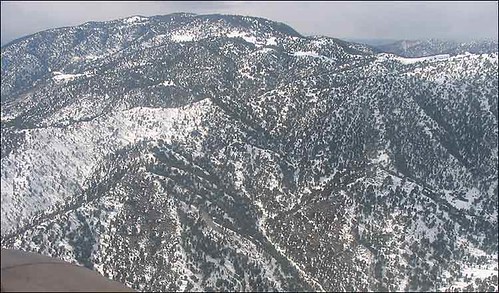 [Image: This is a glimpse of the vast border between Pakistan and Afghanistan as photographed by the BBC in High stakes on Pakistan-Afghan border.]
[Image: This is a glimpse of the vast border between Pakistan and Afghanistan as photographed by the BBC in High stakes on Pakistan-Afghan border.]Meanwhile, Pakistan,
after announcing its plan a few months ago to fence (but no longer mine) large fronts of its border with Afghanistan to restrict the movement of Taliban militants, has said “the erection of the fence in seven or eight different pieces
will take a few months to execute. However,
after flying journalists over mountain tops across the border where “simple markers” merely suggest this border, “and occasional white numbers painted onto mountain tops rise from a wilderness of barren ridges and dried-up creek beds,”Afghan troops have already torn down parts of the fence that have been erected, even exchanging gun fire.

The Foreign Ministry said just a few hours ago that
it would use everything in its means to prevent a fence from being built along their border. ‘We will use all legal tools to stop this fence,’ he said. ‘It is not a solution to crossborder attacks, it divides families living in the area.’
Oh the power of walls. Will the Pak/Afghan border become more unstable than ever? I can’t see that being an unsafe bet.

And while we’re in the region, as amicable as India and Pakistan have become in a recent history, the militarization of their borders is still firmly entrenched and sighted on watching the every movements of each other. In
The Hindu,
we read:
Pakistan has built dozens of new concrete bunkers since the ceasefire, often just metres from the border fence in the Jaurian sector, near Jammu. Two concrete bunkers, for example, now overlook the fence at the BSF's Nikowal Border Observation Post. Should the Pakistan Rangers choose to do so, these bunkers could be used to bring down lethal fire on Indian patrols and counter-infiltration ambushes.
New observation towers, which allow the Pakistan Rangers to closely monitor India's forward positions and troop movements, have also mushroomed throughout the Jaurian sector. Elsewhere in the Jammu region, Pakistani troops have been building new roads and repairing bridges leading to its forward positions — all activities facilitated by the fact that construction workers are no longer being shot at.
India has responded by starting work on a new earth bund, or dyke, from which border guards will have an unobstructed view of the fence — and also be able to dominate the new Pakistan Rangers bunkers. An old dyke which obstructs the BSF troops' view of the border — built, ironically enough, to protect workers building the fence from Pakistani fire — will soon be levelled, clearing the way for more accurate fire targeting infiltrators.
It sounds so childish and back and forth. Tit-for-tat. Like Siamese twins posturing with one another, victims of inseparable self-conflict.
Oh yeah? I’ll see your observation towers with this earth bund. Oh yeah?? But that doesn’t stop them from getting together to bless the border fence in the spirit of Holi; truly a border celebration that could only happen on the border of India. Come on,
check out this video and chant along now:
"Jo shanty chal rahi hai border pe, us hum yeh programme kar rahe hai, Hum log alag states ke rahne wale hain aur jab sare sates ke naach-gane mil jate hai, toh ish Holi ki rang hi kuch alag ban jata hai…”
(In their own English translations: The peace on the borders is a good sign and we can celebrate then … Since we all come from different regions, when different shades of colours mingle, Holi gets an altogether different hue here... It does not matter which region you come from or which community you belong to, we celebrate without any divides.”)
What can I say – I’m down.
I find India the most fascinating country, not just because I spent four months there blown away by the other-planetary nature of the place, but because India ever since the British empire retreated has made every attempt to border itself on all fronts. Just last months the Indian government proposed to fence the Indo-Burma border, and asked the Burmese military junta to cooperate.
Mizzima News reported that “The fencing is deemed necessary to check rampant cross border crime, smuggling, insurgency and other illegal activities.” The
current objective is to fence approximately 10 of the 1,643 km border, which “is used as a safe haven both by insurgents and smugglers, has been is a bone of contention and concern with India.”
Meanwhile, India, as part of the Kaladan multipurpose project, has agreed to invest US $103 million to develop Sittwe port on Burma's northern coast, which will allow India to conduct trade directly with Southeast Asia.
From
India Defence:
“Kaladan project, which includes a 160-kilometre long waterway from Sithway to Mizoram. A sixty-five kilometre long concrete road will also be built in addition to a trilateral road joining More in Manipur, Mairat in Thailand via Bagan in Myanmar.
Mukherjee said talks on constructing a direct gas pipeline between India and Myanmar also featured during the bilateral discussions. He said concerned authorities in Myanmar were working out on the possibilities and logistics so that India got uninterrupted gas supply at a competitive price.”
It pretty much looks like an exchange of military favors for key port development with the intention of strengthening economic ties between the two countries. What kinds of military equipment? Well, who knows, perhaps in the future the Indo-Burma border will eventually be linked up via satellite with the 582 border outposts that string along the Nepalese and Bhutan borders of which the Indian Sashastra Seema Bal (SSB) has just launched
a state-of-the-art surveillance border networking project to forge a detection net in between all of the gaps between the outposts there. But, this kind of technology seems like it could one day perhaps even link up to a more global span of virtual fences.
Moving on we hear that Thailand and Malaysia have agreed to extend a border security wall by another 10 km’s. The state media ran a story in March that described this extension as more than quadrupling the length of an existing 3-km-long fence near Sadao, a Thai border town 750 km’s south of Bangkok just opposite Malaysia’s Kedah state. From
the article, “Thai Prime Minister Surayud Chulanont on Sunday proposed extending the existing border wall by 27 km’s to improve security in the deep South” to (take a guess)… “prevent the flow of illegal workers across the common border.”
“The wall would presumably also prevent Thai separatists from fleeing across the border after perpetrating attacks in Thailand. […] Thailand's deep South - comprising Naratiwat, Pattani and Yala provinces - has been the scene of a separatist struggle for the past five decades.”
In addition,
a new 150m-long wall modeled after the aforementioned, is currently under construction near Lubok Antu in Sri Aman division in Kuching to also “deter the entry of illegal immigrants and smugglers.”
In order to move on from the Asia Pacific, of which I am leaving out more than I care to, let me just say that some good news can occasionally come out of all of this. For example,
South Korea committed to a plan to dismantle parts of a wire fence built that was in the 1950’s to prevent infiltration by North Korean agents. The fence lines a river connecting the capital of Seoul to North Korea. To quote
this article:
The barbed wire fences were installed along the Han River running through Seoul right after the 1950-53 Korean War -- which ended in a truce rather than a peace treaty -- over concerns that North Korean commandoes could use the waterway to infiltrate the South.
The ministry and the city of Gimpo, west of Seoul, said they agreed in principle to dismantle a 8.1-mile section of the southern end of the fence as well as a similar length of the fence set up on the other side of the river.
The ministry declined to give the total length of the fences, saying it was a military secret. But looking at a map, the fence likely stretches well over 60miles.
Currently these fences are seen an inhibiting regional development, and SK’s views of NK have softened over the years, with less worry about NK infiltrators using the river to enter into SK. Though, SK officials plan to “install closed circuit cameras, infrared cameras and other surveillance equipment after dismantling the fences.”
The decision came after years of petitioning by local governments who have pushed the military to open up this specific region for larger and more productive civilian use.
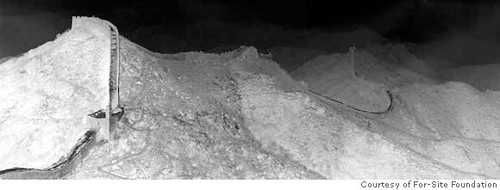 [Image: the Great Wall of China, as phoographed by Shi Gororui.]
[Image: the Great Wall of China, as phoographed by Shi Gororui.]And China, being the proprietor of the
MacDaddy wall of them all, is finally getting their act together to
conduct a four-year study beginning in May to completely map the route of the Great Wall in 13 provinces, check its conditions, and determine what if any archaeological maintenance should be done. After 2,000 years of boasting the world’s largest single man-made structure, I think it is fair to say – about time!
Ok, in order to wrap up this post, let’s cruise back to the land of the Americas, if just to give it that
full-circle feel (remember, we started with the American Wall in Baghdad). So, a few days ago I broke down most of what the U.S. government is doing along the U.S. Mexico border via the SBINet.
Check it out, if you missed it. But besides Sasabe,
other fencing work still carries on, mostly in Arizona now which is by far the most impacted border enforcement state in the U.S. right now. Some relatively new vehicle barriers in western Arizona have begun to topple the landscape in addition to barriers along the southern boundary of the Buenos Aires National Wildlife Refuge.
National Guard troopers are installing X-shaped barriers made of railroad track. They resemble the barriers German troops installed along the Normandy beach in World War II to thwart allied invasion boats.
The new vehicle barriers are going up along a 37-mile stretch at the Barry M. Goldwater Bombing Range east of Yuma. But the barriers won’t be used at the nearby Cabeza Prieta National Wildlife Refuge.
And while European Union foreign policy chief Javier Solana delivered a recent
scathing statement about walling
La Linea, saying “immigrants should be treated like people and not like criminals,” (and while I agree with and appreciate his criticism) he should also then be willing to address what is taking place in Spain and all along the North African frontier where Europe has outsourced a vast detention front to treat African immigrants like criminals on soil just outside their own.
Nevertheless, Homeland Security oficials are conducting
public dialogues with many of the Rio Grande’s landowners to determine the feasibility and public tolerance of establishing border fencing and different barriers on private ranches there. Many, as you might not expect, are skeptical of the plan, and see the fence as creating worse conflicts than the current situation.
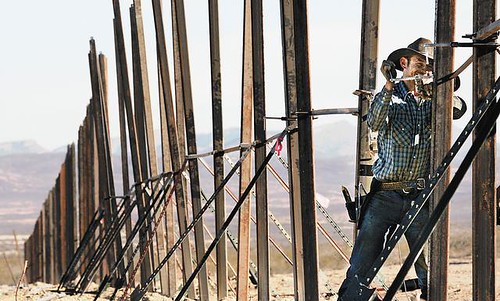 [Image: Minuteman fence rising on border ranch, Arizona Daily Star.]
[Image: Minuteman fence rising on border ranch, Arizona Daily Star.]But, others are much more willing to turn over their property to the hubris of border militarization. And guess who's there to capitalize on that offer? Yup, those crazy whacky dudes you just can’t get any more annoyed by – the Minutemen. You got to hand it to them, though, they do somewhat have their shit together (in terms of being able to mobilize). They have been quite successful at raising thousands of dollars and organizing massive volunteer efforts with their own Civil Defense Corps to build large extensions of fencing all over the place. They just finished a
7 ½ mile barbed wire fence on a Palominas ranch in Arizona. Last fall, the Minuteman Civil Defense Corps broke ground on
a second fence project about four miles east of Naco on private ranch. When completed, the barrier is expected to cost about $650,000. However, "A shortage of funds and volunteer manpower has stalled plans by the Minuteman Civil Defense Corps to build a border fence at
a private ranch near Bisbee Junction."
Everyone and their mother these days seems involved some how in the construction of a border fence. But, thankfully not without some at least minor but no less significant attempts at a counter balance.
Activists in the Netherlands
recently cut away a protective fence at a port housing a new fleet of prison hulks that are set to go into operation. Such vessels are essentially floating prisons capable of housing large groups of immigrants for extended periods of time.

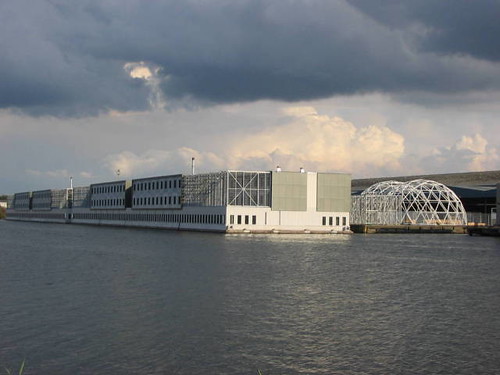 [Image: 'opening' of prison boats' in the Netherlands, via delete the border and Indymedia.]
[Image: 'opening' of prison boats' in the Netherlands, via delete the border and Indymedia.]What can I say, I love their garb, their mission, their tact. If any readers out there have been hawking news on these prison vessels, please contact me, would love to get some more scoop.

But hey, it's not only the U.S. in the land of the Americas who are building bombastic border fences. Brazil
confirmed that it will build a steel and concrete wall along the Paraguayan border "to help combat contraband in the Triple frontier area where Brazil, Argentina and Paraguay meet."
According to the official Agência Brasil, the one mile long by three meters high wall perpendicular to the river Paraná, and next to the Brazilian city of Foz de Iguaçu, should be finished by next July and will be equipped with all the gadgets common to a high security presidium.
The purpose of the wall, say Brazilian authorities, is to stop smugglers from buying cheap imported goods in Paraguay's Ciudad del Este and selling them in the big Brazilian cities such as São Paulo. Computers, electronics, cigarettes, watches, brand textiles are some of the most common items smuggled.
Brazil, which has a significant Arab community has always rejected US claims that the Triple frontier area has become an operational base for Middle East fundamentalists and extremists. However, according to the Brazilian press, strangely enough the initiative was leaked during the visit to Brazil of US president George Bush.
More
info on the political context
here and
here.
In more absurd contestations of border wall construction, a couple in Canada are challenging the government
after building a retaining wall, “which border officials say must be moved back two feet, just south of the U.S.-Canadian border in Blaine, Wash.” As it was apparently built too close, “or more accurately,” according to this article, “right on the border.” From the same source we learn that “No construction is allowed and no trees or shrubs can be planted in the 20-foot buffer zone.”
And in case you wonder about the significance of the greater struggle to bring down the walls and force the more conscientious alternative, we are reminded by this story that no wall is too small to keep fighting the good fight. Some small group of residents in Contra Costa County, California,
have been struggling for a decade now to have a simple chain link fence removed from the end of their road that leads to a park, where once drug dealers used a house there to conduct their business. However, locals and even city officials recognize that since the house has been reoccupied and with the barrier the drug activity has receded into the park, where ironically the police can no longer access or patrol due to the chain link fence. Most residents there have voiced that they want the fence removed, but due to some official department jurisdiction issue and funding excuses the city still has failed to take any action. Now the group of fed-up locals are planning to rip the thing out of the ground themselves, as they contend the fence has long prevented multiple road access to their neighborhood and homes and discourages their own use of the nearby park.
Go people go!
Anyway, all this is more to the point – that the walls never grow any less political over time. In fact, the opposite seems more true – border to border, wall to wall, fence to fence, the politics of movement never stops taking shape or assuming new spatial forms, neither does it cease to affront us, even in the most subtle of ways. And unless communities rally, like they did in Baghdad, or the Netherlands, and along the U.S./Mexico border, and so on, these partitions will go on cleavering the landscape and insinuating themselves as the built emblems of a colossally skewed distribution of global income, disingenuous labor practice, and informal warehousing of the poor. A significant minority of the world will in essence be turned into a giant gated community while leaving a majority to perpetually wander along side a new
great wall of capitalist exclusion, of sorts, looking for some way into the Promised Land. Not the future any of us want to imagine, is it?
Previously:
Casting the SBINet :
Stealth Wall Removal :
At the Checkpoint :
The Green Line :
Face to Face :
U.S. vs. Mexico (Border Ball is on!) :
Border Fences-R-Us :
Great Wall Preservatives :
A Porcelain Fence :
'Tactical Infrastructure' and the 'Border Calculus' :
Wall(s) of Light :
The Participatory Panopticon at the border... :
Resist the Apartheid Walls, from Palestine to Mexico :
More Fence Sprouts :
An Embroidered Wall :
The Saudi's Immigrant-hunting Border Fence :
Padua's Berlin Wall :
Welcome to America :
Call it 'Border Ball' :
An Equator of Borderzones :
urban syntax: at the border... :
"Thinking of Walls" :
Border CTRL :
Rival Actions: at the border... :
Bethlehem Prison City Gates :
Three Ehxibits: on Walls & Political Divide




